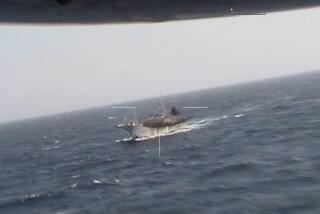China’s man-made islands in disputed waters raise worries
- Share via
Reporting from Washington — China is rapidly building five man-made islands from tiny reefs and shoals in the South China Sea, U.S. officials say, sparking concern that Beijing is growing more assertive in the disputed waters even as the United States boosts its own forces in the western Pacific.
Dredging around Fiery Cross Reef, a former outcropping in the Spratly Islands, over the last year has created a new island nearly 2 miles long and several hundred yards wide.
U.S. officials say it is large enough for China to build its first airstrip in the remote archipelago, one long enough for most of its combat and support aircraft. Satellite photos also reveal a small port under construction.
U.S. officials worry that the buildup indicates a Chinese push to establish de facto control over the resource-rich waters and islets also claimed by the Philippines, Malaysia, Taiwan, Brunei and Vietnam.
Except for Brunei, those nations all maintain small airstrips or symbolic military outposts in the Spratlys, but the Chinese military dwarfs others in the region and could undermine the tense status quo. Confrontations have broken out over fishing, oil and gas drilling and military maneuvers in recent years.
India is the latest country to express alarm about Beijing’s growing military clout, partly because the Chinese navy has sent nuclear submarines into the Indian Ocean, rattling New Delhi’s defense community.
During a three-day visit to New Delhi that ended Tuesday, President Obama signed a joint statement with Indian Prime Minister Narendra Modi calling for “safeguarding maritime security and ensuring freedom of navigation and overflight throughout the region, especially in the South China Sea.” They urged all parties “to avoid the threat or use of force.”
White House aides portrayed Obama’s trip as a way to emphasize his attempt to focus more military and other resources on Asia and the western Pacific, a pivot intended in part to offset China’s influence. The Pentagon has sent more warships and troops to the region and has forged closer military ties with several of China’s neighbors.
A military-grade airstrip and dredged harbor on Fiery Cross Reef, which lies on the western edge of the Spratly archipelago, clearly would expand China’s ability to operate in an area considered a potential tinderbox. Land reclamation is also underway at Johnson South Reef, Johnson North Reef, Cuarteron Reef and Gaven Reef.
“China appears to be expanding and upgrading military and civilian infrastructure — including radars, satellite communication equipment, antiaircraft and naval guns, helipads and docks — on some of the man-made islands,” according to a report last month by the U.S.-China Economic and Security Review Commission, which was set up by Congress.
Beijing insists the reclamation projects are an internal matter taking place on Chinese territory, and recently said it needs a base in the South China Sea to support radar and intelligence gathering. It has rebuffed regional demands to submit to international arbitration to resolve the maritime and territorial disputes.
The White House has refused to take sides in the territorial disputes, calling for a halt in all provocative activities. But the Obama administration faces growing pressure from allies to push back any Chinese effort to establish a permanent offshore military presence in the contested area.
Pentagon officials and the State Department repeated those demands in the last week, urging China to halt the island-building projects.
“We call on China to clarify their reclamation intentions” and “to cease these large-scale reclamation activities, recognize how they are increasing regional tensions, and pursue diplomatic alternatives,” said Lt. Col. Jeffrey Pool, a Pentagon spokesman.
“They’re reclaiming land in shoals and rocks in sensitive areas whose sovereignty is contested,” Assistant Secretary of State Daniel R. Russel said at a Jan. 21 news conference in Manila. “We think there is a powerful case to be made for the maximum exercise of restraint.”
Evan P. Garcia, a senior Philippine diplomat, told reporters the island-building “is not helpful in terms of finding a way forward.... It’s so frustrating.”
In late 2013, China’s Defense Ministry sparked deep unease when it warned that it would take “defensive emergency measures” against foreign aircraft that did not give notification before entering an air-defense identification zone that Beijing had declared off its coast.
In response, the Pentagon sent a pair of unarmed B-52s over the East China Sea to challenge the Chinese claim. The crisis was defused when China backed down and signaled it would not endanger the lives of pilots and passengers.
Pentagon officials were furious in August when a Chinese fighter jet did a barrel roll over a U.S. Navy P-8 Poseidon surveillance aircraft over the South China Sea, and the White House called the incident a deliberate provocation. In 2001, a Chinese fighter jet collided with a Navy EP-3 surveillance plane, forcing it to make an emergency landing on nearby Hainan island.
At the same time, the Chinese military still faces severe limitations. Most of its fighter aircraft lack the range to patrol over the Spratly Islands, which lie more than 600 miles from China’s nearest air base and more than 400 miles from a Chinese airstrip in the Paracel Islands at the northern end of the sea, according to the report by the congressional commission.
Its navy similarly has a limited ability to operate in open waters for long periods because it lacks offshore bases for refueling and resupply, according to U.S. officials who requested anonymity because of the sensitivity of discussing China’s military. China launched its first aircraft carrier in 2012, but the ship is not expected to be capable of flight operations until 2016, at the earliest.
A senior Chinese military official said in November that Chinese leaders decided to expand a military presence in the South China Sea after participating in the multinational search for Malaysia Airlines Flight 370, which disappeared March 8 while flying from Kuala Lumpur to Beijing with 239 people aboard.
The pilots made their last voice contact over the South China Sea, although the search soon expanded to the vast reaches of the southern Indian Ocean. Debris from the missing jet still has not been found.
“There is a need for a base to support our radar system and intelligence-gathering activities,” Jin Zhirui of the Chinese air force headquarters told reporters at the Xiangshan Forum, a Beijing national security conference, according to news reports.
The search “made us realize we lacked sufficient air force capabilities in the South China Sea,” Jin said. “There is a need for a base of operations in the South China Sea for state security and to protect national interests.”
China is unlikely to build a major military base in an area regularly hit by typhoons, said Jeffrey Engstrom, an Asia security expert at Rand Corp., a Santa Monica-based think tank. But, he said, the “man-made islands would be useful for establishing presence and limited power projection in the South China Sea.”
Times staff writer Julie Makinen in Beijing contributed to this report.
MORE FROM CHINA
Birthrate drop feared in upcoming year of the sheep
TV series runs afoul of censors for showing too much cleavage
More to Read
Sign up for Essential California
The most important California stories and recommendations in your inbox every morning.
You may occasionally receive promotional content from the Los Angeles Times.











